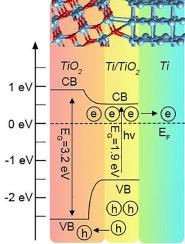Journal of Materials Science & Technology ( IF 11.2 ) Pub Date : 2021-09-23 , DOI: 10.1016/j.jmst.2021.06.081 Yangfan Zhang 1 , Yao Li 2 , Han Yu 1, 3 , Kai Yu 1 , Hongbing Yu 1

|
Defect sites on oxide semiconductors play a crucial role in promoting photocatalytiperformance and modulating the bandgap structure of photocatalysts. However, the role of interfacial coordinatively unsaturated defect sites between metal and oxide in photocatalysis is still under debate. So, we designed an experiment to probe the role of interfacial coordinatively unsaturated defect sites. In this work, a series of Ti/TiO2 photocatalysts with varying concentrations of interfacial Ti3+ sites were prepared through an epitaxial growth method under hydrothermal conditions. Through experimental and computational investigations, the roles of interfacial defect sites were discussed in detail. On the one hand, the interfacial coordinatively unsaturated Ti3+ sites could act as visible-light-responsive sites in photocatalytic reactions due to the overlap and hybridization of multiple electronic orbitals. On the other hand, the Ti/TiO2 interface exhibited a certain degree of metallic character near the Fermi level because of the partial delocalization and redistribution of electrons, facilitating the charge migration and separation across the metal-oxide interface. Consequently, the obtained Ti/TiO2 catalysts showed notably enhanced charge transfer efficiency and visible light photocatalytic activity compared to their pristine counterparts. This work may provide a new perspective to interfacial defect engineering in classic metal/oxide heterojunction photocatalysts and figure a more precise direction to synthesize higher effective photocatalysts for environmental governance.
中文翻译:

Ti/TiO2 上的界面缺陷 Ti3+ 作为具有促进电荷转移和光催化性能的可见光响应位点
氧化物半导体上的缺陷位点在促进光催化性能和调节光催化剂的带隙结构方面起着至关重要的作用。然而,金属和氧化物之间的界面配位不饱和缺陷位点在光催化中的作用仍存在争议。因此,我们设计了一个实验来探讨界面协调不饱和缺陷位点的作用。在这项工作中,通过外延生长方法在水热条件下制备了一系列具有不同浓度界面 Ti3+ 位点的 Ti/TiO2 光催化剂。通过实验和计算研究,详细讨论了界面缺陷位点的作用。一方面,由于多个电子轨道的重叠和杂化,界面配位不饱和Ti3+位点可以作为光催化反应中的可见光响应位点。另一方面,由于电子的部分离域和重新分布,Ti/TiO2 界面在费米能级附近表现出一定程度的金属特性,促进了跨越金属-氧化物界面的电荷迁移和分离。因此,与原始催化剂相比,所获得的 Ti/TiO2 催化剂显示出显着提高的电荷转移效率和可见光光催化活性。











































 京公网安备 11010802027423号
京公网安备 11010802027423号